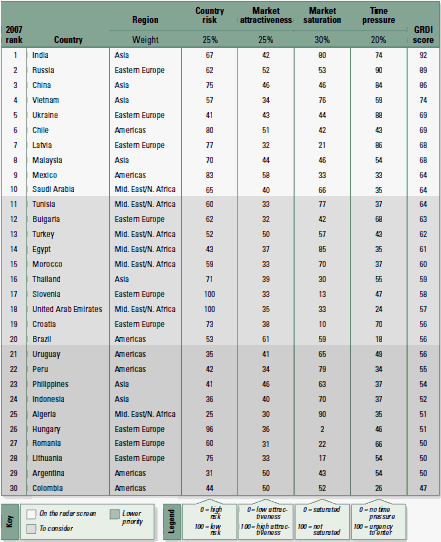As larger cities in India, China and Russia reach retail saturation, some retailers are entering countries through smaller second- and third-tier cities where consumers are ready to embrace Western-style retail concepts and products thanks to the influence of television, movies and the Internet.This is one of the findings of the sixth annual Global Retail Development Index™ (GRDI), a study of retail investment attractiveness among 30 emerging markets conducted by management consulting firm A.T. Kearney.
Published since 2001, the GRDI helps retailers prioritize their global development strategies by ranking emerging countries based on a set of 25 variables including economic and political risk, retail market attractiveness, retail saturation levels, and the difference between gross domestic product growth and retail growth. The GRDI focuses on opportunities for mass merchant and food retailers, which are typically the bellwether for modern retailing concepts in a country.
India and Russia continue to occupy the top two spots of the GRDI in 2007, as they have for the last three years. China vaulted past Vietnam and Ukraine to place third in this year's index, largely on the strength of continued growth in consumer spending and retailers moving into smaller markets. Modern retail formats grew between 25 and 30 percent in India and 13 percent in both China and Russia in the last year.
Until recently, such rapid growth was confined to the largest cities in each country. However, increased competition in those cities is quickly forcing domestic and global retailers to expand into smaller second- and third-tier cities to drive growth. In China, foreign retailers such as Wal-Mart and Tesco, and Hong Kong-based retailers are branching into smaller mainland cities, such as Yuxi, Weifan, Nanchang and Wuhu. In Russia, Carrefour recently announced it is entering the country via tier-two cities. And in India, shopping center developer Prozone is focusing development on smaller cities in anticipation of growing demand for modern retailers.
But all cities are not created equal.
"Retailers should not go into second-tier cities armed with a first-tier strategy," said Mike Moriarty, a partner with A.T. Kearney and co-leader of the GRDI. "Successfully entering a new country via smaller cities requires careful identification of cities with consumers who are ready to embrace modern retail formats. Incomes are smaller and products need to be customized for different markets. But with the right strategy, smaller cities can be attractive targets for retailers that missed the 'window of opportunity' in major cities and for established retailers looking for growth."


